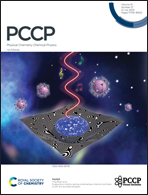Quantifying quadrupole effects in the NMR spectra of spin-1/2 nuclei in rotating solids†
Abstract
Quantifying the NMR spectra of spin I = 1/2 nuclei coupled to quadrupolar spins (nuclei with spin quantum number, S > 1/2) has remained an arduous task in solid-state magic angle spinning (MAS) NMR experiments. In particular, extraction of chemical shift anisotropy (CSA) tensors from line-shapes of spin I = 1/2 nuclei coupled to quadrupolar spin (S = 1) in MAS experiments has remained challenging owing to the simultaneous presence of both heteronuclear dipolar interactions and quadrupolar interactions. Unlike experiments that involve only spin-1/2 nuclei, both faster spinning frequencies and stronger decoupling field strengths on the quadrupolar spins are essential to average/minimize the contributions from heteronuclear dipolar interactions. To this end, a quantitative theory based on the concept of “effective fields” is proposed to deduce optimal conditions in experiments that involve simultaneous recoupling and decoupling of heteronuclear dipolar interactions. Through analytic expressions, the spectral frequencies and intensities observed in experiments are quantified and rigorously verified. Since extraction of molecular constraints in NMR experiments involves iterative fitting of experimental data, we believe that the analytic expressions derived would speed up and be beneficial in quantifying such experiments.

- This article is part of the themed collection: 2023 PCCP HOT Articles


 Please wait while we load your content...
Please wait while we load your content...